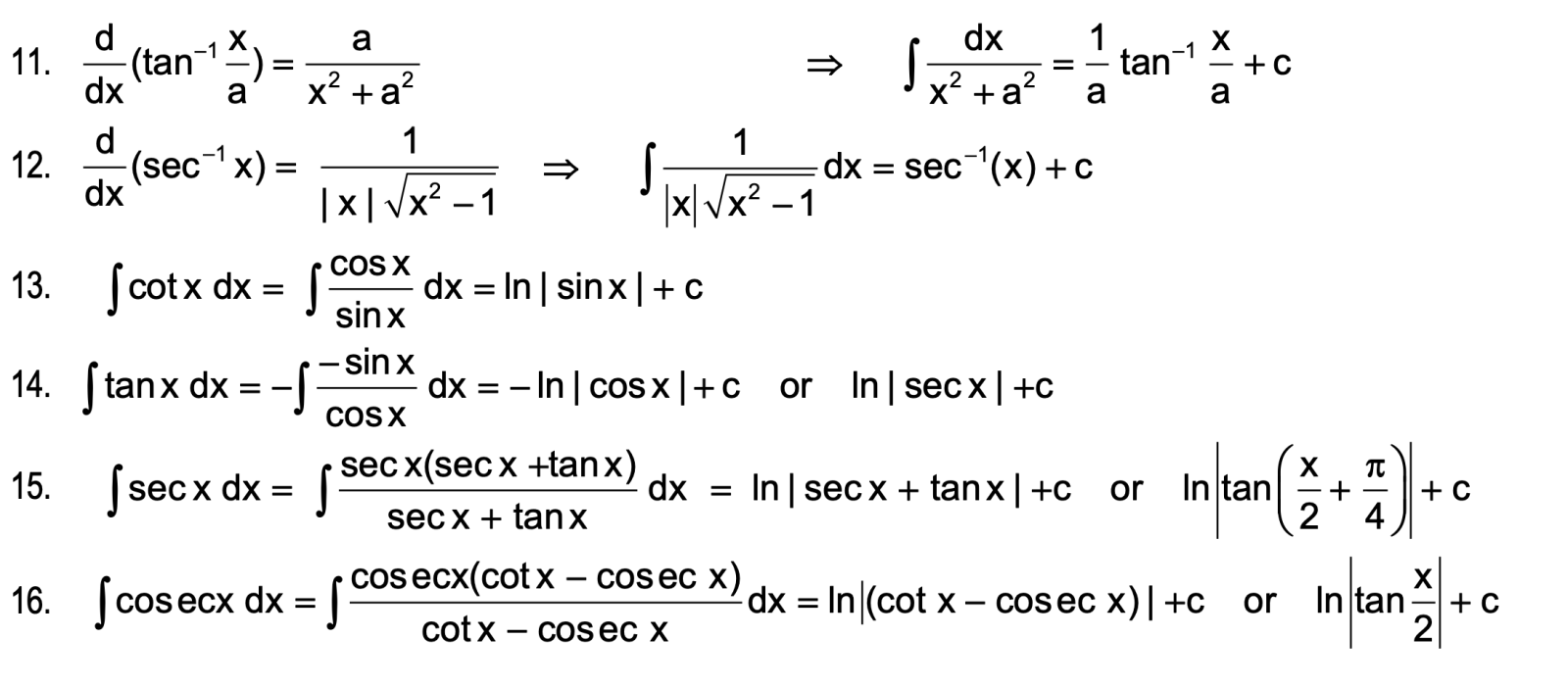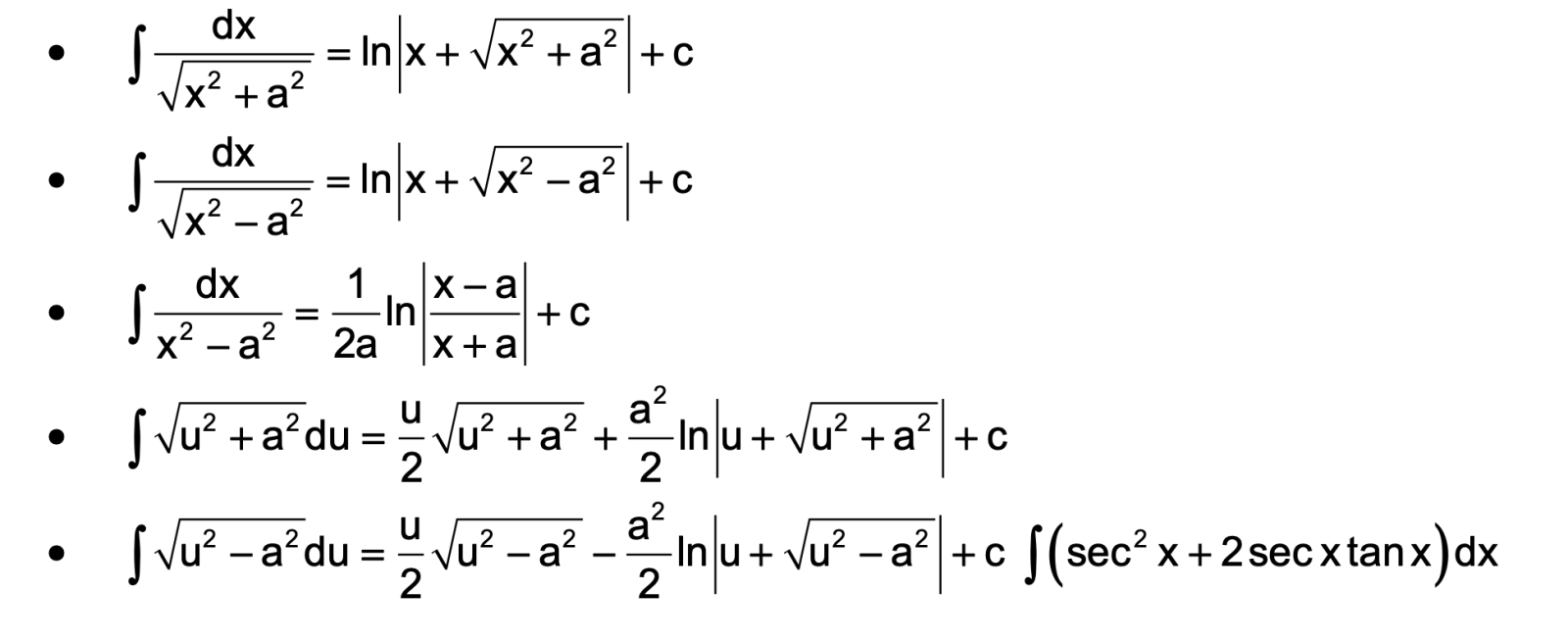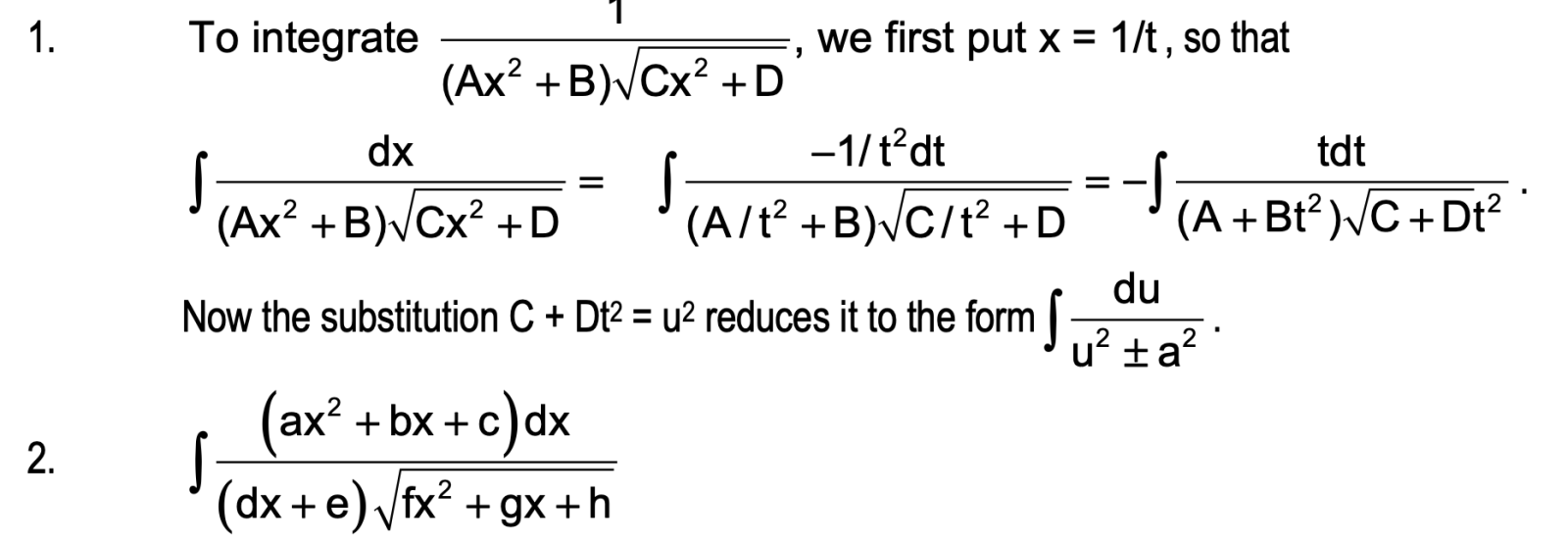DEFINITION: BASIC CONCEPT
Let F(x) be a differentiable function of x such that. Then F(x) is called the integral of f(x). Symbolically, it is written as ∫ f(x) dx = F(x).
f(x), the function to be integrated, is called the integrand.
F(x) is also called the anti-derivative (or primitive function) of f(x).
d/dx [ F(x) ] = f(x)
Constant of Integration
As the differential coefficient of a constant is zero, we have
d/dx ( F(x) ) = f(x) ⇒ d/dx [ F(x) + c ] = f(x).
Therefore, ∫f(x) dx = F(x) + c.
This constant c is called the constant of integration and can take any real value.
Integration as the Inverse Process of Differentiation
Basic formulae
Anti-derivatives or integrals of some of the widely used functions (integrands) are given below.
Derivatives and Integrals
1. d/dx ( xn+1 / n+1 ) = xn ⇒ ∫ xn dx = xn+1/n+1 + c , n ≠ -1
2. d/dx ( ln |x| ) = 1/x ⇒ ∫ 1/x dx = ln |x| + c
3. d/dx ( ex ) = ex ⇒ ∫ ex dx = ex + c
4. d/dx ( ax ) = ax ln a ⇒ ∫ ax dx = ax / ln a + c (a > 0)
5. d/dx ( sinx ) = cos x ⇒ ∫ cos x dx = sin x + c
6. d/dx ( cos x ) = - sin x ⇒ ∫ sin x dx = - cos x + c
7. d/dx ( tan x ) = sec2 x ⇒ ∫ sec2 x dx = tan x + c
8. d/dx ( cosec x ) = - cot x cosec x ⇒ ∫ cosec x cot x dx = -cosec x + c
9. d/dx ( cot x ) = - cosec2 x ⇒ ∫ cosec2 x dx = -cot x + c
10. d/dx ( sin-1 x/a ) = 1 / root a2 - x2 ⇒ ∫ 1 root a2 - x2 dx = sin-1 ( x/a ) + c

Standard Formulae

METHODS OF INTEGRATION
If the integrand is not a derivative of a known function, then the corresponding integrals cannot be found directly. In order to find the integral of complex problems, generally three rules of integration are used.
(1) Integration by substitution or by change of the independent variable.
(2) Integration by parts.
(3) Integration by partial fractions.
INTEGRATION BY SUBSTITUTION
Direct Substitution

Indirect Substitution
If the integrand is of the form f(x)g(x), where g(x) is a function of the integral of f(x), then put integral of f(x) = t.
INTEGRATION BY PARTS
If u and v be two functions of x, then integral of product of these two functions is given by:
∫ u v dx = u ∫ v dx - ∫ [du/dx ∫ v dx ] dx
(Inverse, Logarithmic, Algebraic, Trigonometric, Exponent)
In the above stated order, the function on the left is always chosen as the first function. This rule is called as ILATE e.g. In the integration of ∫ x sin x dx, x is taken as the first function and sinx is taken as the second function.
Ex.: ∫ sec (tan–1 x) dx can be rewritten as
(A) ∫ sec2 θ dθ where θ = tan–1 x
(B) ∫ sec3 θ dθ where θ = tan–1 x
(C) ∫ cot2 θ dθ where θ = cos–1 x
(D) ∫ sec θ dθ where θ = sin–1 x
Solution:(B).
I = ∫ sec (tan–1 x) dx Let tan–1x = θ ⇒ x = tan θ ⇒ dx = sec2θ dθ
∴ I = ∫ sec3 θ dθ = sec θ ∫ sec2 θ dθ – ∫ tan θ (sec θ tan θ) dθ
= sec θ tan θ – ∫ (sec2 θ – 1) sec θ dθ
= sec θ tan θ – ∫ sec θ tan θ dθ + ∫ sec θ dθ
= sec θ tan θ – I + ln|sec θ + tan θ|
⇒ I = ½ [sec θ tan θ] + ½ ln|sec θ + tan θ| + c
An important result: In the integral ∫ g(x)exdx, if g(x) can be expressed as
g(x) = f(x) + f′(x) then ∫ ex[f(x) + f′(x)]dx = exf(x) + c
ALGEBRAIC INTEGRALS
Integrals of the form
∫ (px + q) / (ax² + bx + c) dx, ∫ (px + q) / √(ax² + bx + c) dx, ∫ (px + q) √(ax² + bx + c) dx
In these type of integrals we write px + q = ℓ (diff coefficient of ax² + bx + c) + m.
Find ℓ and m by comparing the coefficient of x and constant term on both sides of the identity. In this way the question will reduce to the sum of two integrals which can be integrated easily.
Integral of the type (ax² + bx + c) / (px² + qx + r) or (ax² + bx + c) / √(px² + qx + r)
In this case substitute ax² + bx + c = M (px² + qx + r) + N (2px + q) + R.
R. Find M, N, & R. The integration reduces to integration of three independent functions.
Integration of Irrational Algebraic Fractions

Here, we write, ax2 + bx + c = A1 (dx + e) ( 2fx + g) + B1( dx + e) +C1
where A1, B1 and C1 are constants which can be obtained by comparing the coefficient of like terms on both sides. And given integral will reduce to the form

TRIGONOMETRIC INTEGRALS
Integrals of the form
(i) ∫ (p cosx + q sinx + r) / (a cosx + b sinx + c) dx
(ii) ∫ (p cosx + q sinx) / (a cosx + b sinx) dx
Rule for (i): In this integral express numerator as l (Denominator) + m (d.c. of denominator) + n. Find l, m, n by comparing the coefficients of sinx, cosx and constant term and split the integral into sum of three integrals.
l ∫ dx + m ∫ [d.c. of (Denominator)] / Denominator dx + n ∫ dx / (a cosx + b sinx + c)
Rule for (ii): Express numerator as l (denominator) + m (d.c. of denominator) and find l and m as above.
Integration of the Type: ∫(sinMx cosNx)dx
M & N ∈ natural numbers.
- If one of them is odd, then substitute for term of even power.
- If both are odd, substitute either of the term.
- If both are even, use trigonometric identities only.
Ex.: Evaluate ∫√sin x cos x dx
(A) 3⁄2 (sin x)3/5 + c
(B) 2⁄3 (sin x)3/2 + c
(C) 2⁄3 (cos x)3/2 + c
(D) 2⁄3 (sin x)1/4 + c
Solution: (B).
Put sin x = t
∫ t1/2 dt = 2⁄3 t3/2 + c
= 2⁄3 (sin x)3/2 + c.
Formulas and Concepts
1. For ∫ f(g(x)) g'(x) dx, put g(x) = t, provided ∫ f(t) dt exists.
2. ∫ u v dx = u ∫ v dx - ∫ [du/dx ∫ v dx] dx. For selecting ‘u’ use ILATE.
3. ∫ ex [f(x) + f'(x)] dx = exf(x) + c.
4. For 1/(A x² + B)√(C x² + D) , we first put x = 1/t, and then substitute C + D t² = u² to get the form ∫ du / (u² ± a²).
5. For ∫ (a x² + b x + c) dx / (dx + e)√(f x² + g x + h) . Put a x² + b x + c = A₁(dx + e)(2f x + g) + B₁(dx + e) + C₁ and proceed.
6. For ∫ p cos x + q sin x + r / a cos x + b sin x + c dx, express numerator as l (Denominator) + m (d.c. of denominator) + n.
Frequently Asked Questions
Indefinite integrals, or antiderivatives, are central to solving problems wherever you have information about a rate of change and need to reconstruct the original quantity. In physics, they’re used to find position from velocity or acceleration data. In engineering, they help determine accumulated quantities such as charge, energy, or stress from rates of change. In biology, indefinite integrals assist in modeling growth from known rates.
These tools also feature in financial mathematics and economics to recover total amounts from marginal (rate-based) information. Their broad applicability makes them indispensable for analysis, modeling, and problem-solving in a wide range of technical fields.
The Gaussian integral is named for its relationship to the Gaussian (normal) distribution, central in statistics and many natural phenomena. Its classic form, ∫ e-x² dx over the entire real line, surprisingly evaluates to √π. This integral, and the bell-shaped curve it defines, owe their name to the mathematician Carl Friedrich Gauss, whose work underpins much of modern mathematics and science.
The Riemann integral computes the area under curves by summing slices over intervals, and it works well for continuous or piecewise continuous functions. The Lebesgue integral, by contrast, partitions the range of a function rather than its domain, making it far better suited for "irregular" functions and for applications in probability and advanced analysis.
While both agree on well-behaved functions, the Lebesgue approach generalizes integration to a larger class of functions, forming the basis for modern developments in mathematics and engineering.
The Riemann integral is named after Bernhard Riemann, who provided a rigorous definition of integration in the 19th century. His approach, based on the idea of summing areas of rectangles under a curve and then taking the limit as the rectangles become infinitesimally narrow, brought clarity and foundation to the concept of integration in analysis.
The method is still the cornerstone of calculus education and is used to define integrals for most “well-behaved” functions encountered in calculus and applied mathematics.
Generally, yes students often find integration (especially indefinite integration) more difficult than differentiation. Differentiation follows straightforward, repeatable rules, while integration requires “working backwards,” which can be much less direct.
Integration problems may call for creative substitutions, use of algebraic manipulation, and familiarity with various advanced methods—some integrals do not even have elementary solutions. Mastering differentiation is an essential prerequisite to tackling integration, and spending time practicing a wide variety of integrals is crucial for building mathematical maturity.
In the typical sequence of calculus study, indefinite integrals are introduced first. This ordering matches the logical flow: you must first be able to find the general antiderivative (indefinite integral) before you can use it to evaluate definite integrals (areas, accumulated values). Historically, mathematicians discovered the antiderivative concept before formalizing the definite integral and its link via the Fundamental Theorem of Calculus.
This progression helps students build essential skills in function manipulation and prepares them for applied problems involving definite integration.
Many students find indefinite integrals more challenging than definite integrals. While evaluating a definite integral typically involves finding the antiderivative and substituting end-points, finding the indefinite integral itself often requires deeper understanding, pattern recognition, and creative application of integration techniques. Some integrals can’t be written in terms of elementary functions, further increasing complexity.
Definite integrals benefit from geometric intuition (such as area under a curve), and any constant of integration cancels out during evaluation. In contrast, indefinite integration tests one’s mastery of calculus rules and deeper mathematical reasoning.
Indefinite integrals are critical because they let you reconstruct an original function when you know only its rate of change—this reversal, or antidifferentiation, is fundamental to modeling, predicting, and understanding dynamic systems in science, engineering, economics, and beyond. Whenever only a rate (like velocity, or marginal cost) is known, indefinite integration retrieves the related underlying function (position or total cost).
Indefinite integrals also provide the key step in solving many types of differential equations, the backbone of mathematical modeling in applied and theoretical domains. Without them, much of the predictive and analytical power of mathematics would be lost.
Integrals underpin numerous aspects of daily life and modern engineering. They are used to compute areas and volumes of complex shapes (architecture, civil engineering), to calculate accumulated quantities over time (distance traveled from speed, total electricity used), and to solve problems in physics (center of mass, work done). In statistics, integrals are essential for probability density functions and expected values.
Their impact extends to economics (calculating earnings or costs), biology (population modeling), and medicine (drug absorption rates). Mastery of integrals equips students and professionals to address practical, real-world problems creatively and accurately.
An indefinite integral is a core concept in calculus that represents the general antiderivative of a function. When you integrate a function, you’re determining all possible functions whose derivative would return the given function.
Unlike a definite integral—which calculates the total accumulation, such as the area under a curve within specific bounds an indefinite integral yields a family of functions, always including an arbitrary constant typically written as “+C.” This constant reflects the principle that the derivative of any constant is zero, so antiderivatives always have this inherent ambiguity.
In mathematical terms, the indefinite integral of a function f(x) with respect to x is denoted as ∫f(x)dx. For example, ∫2x dx = x2 + C because the derivative of x2 + C is 2x. Mastery of indefinite integrals is key for reconstructing unknown functions from their rates of change, solving differential equations, and applying calculus across physics, engineering, and economics.
For indefinite integrals, the result is a family of functions, not a single number. However, the antiderivative itself might become infinite for certain values of x (e.g., ln|x| as x approaches 0). When discussing "integral is infinity," people often mean improper definite integrals.
integrals over unbounded domains or with unbounded integrands—that may diverge (fail to converge to a finite number). It's crucial to specify the domain and context when dealing with such cases and be cautious of singularities or points where the antiderivative is not defined.
The indefinite integral of a function is unique up to an additive constant. This means that if you find two antiderivatives F(x) and G(x) for the same function f(x), then F(x) - G(x) is always a constant. This principle underlies the necessity of including "+C" in solutions: differentiation removes constant terms, so antidifferentiation can't recover them without extra information (like an initial value). In applied contexts, this constant is often determined by boundary or initial conditions specific to the problem.
Key theorems for indefinite integrals include:
1. Linearity: ∫[af(x) + bg(x)] dx = a ∫f(x) dx + b ∫g(x) dx, where a and b are constants.
2. Uniqueness Up to a Constant: All antiderivatives of a function differ only by a constant.
3. Substitution (Change of Variables): If u = g(x), then ∫f(g(x))g'(x)dx = ∫f(u)du.
4. Integration by Parts: ∫u dv = uv - ∫v du.
Understanding and applying these theorems enables accurate, efficient integration and underpins many calculus applications.
U-substitution is an essential technique for tackling indefinite integrals involving composite functions or where part of the integrand is the derivative of another part. It involves setting u = g(x), transforming the entire integral in terms of u and du, integrating, and then substituting back in for x. For example, to compute ∫2x cos(x²) dx, set u = x², so du = 2x dx, and the integral becomes ∫cos(u) du = sin(u) + C = sin(x²) + C. Mastery of u-substitution significantly expands the types of integrals you can solve by hand.
- Direct Integration: Use standard formulas for basic functions.
- Substitution (u-sub): Change variables to simplify composite functions.
- Integration by Parts: For integrals of products, using the rule ∫u dv = uv - ∫v du.
- Partial Fractions: Split rational functions into easier fractions.
Additional techniques (such as trigonometric substitution and using identities) further expand your integration toolkit, but the above methods cover most cases in introductory calculus.
To find an indefinite integral, start by identifying the form of the integrand. If it matches a basic pattern (polynomial, exponential, etc.), apply the relevant rule.
Use linearity to split sums; for products or compositions, apply substitution (u-sub), integration by parts, or partial fractions as needed. After working through the integral, always add the constant +C. For example, ∫3x2 dx = x3 + C. For more complex forms, use substitution: set u as an inner function, change variables, and integrate, then substitute back. Practice and familiarity with formulas are essential for success.
Definite integrals and indefinite integrals play related but distinct roles in calculus. An indefinite integral (∫f(x)dx) is the general antiderivative and returns a function (with +C). Its purpose is to find all possible original functions that, when differentiated, yield f(x).
By contrast, a definite integral (∫abf(x)dx) computes a specific numerical value representing the total accumulation (e.g., area under a curve) between limits a and b. The constant C is not included because it cancels out during evaluation. Definite integrals are widely used for calculating physical quantities like area, volume, work, and probabilities.
The constant “C” in indefinite integrals serves a crucial mathematical role. When finding the antiderivative of a function essentially reversing differentiation you lose information about any constant term that might have existed because the derivative of a constant is always zero. Because of this, an indefinite integral represents not a single solution, but an entire family of possible solutions, each differing by a constant value.
For example, both x2 + 4 and x2 - 10 share the derivative 2x. Therefore, ∫2x dx must include +C to capture all possibilities: ∫2x dx = x2 + C. This convention is not just formal it ensures completeness in solutions, which is particularly vital in physics, engineering, and other fields requiring initial conditions or boundary value analysis.